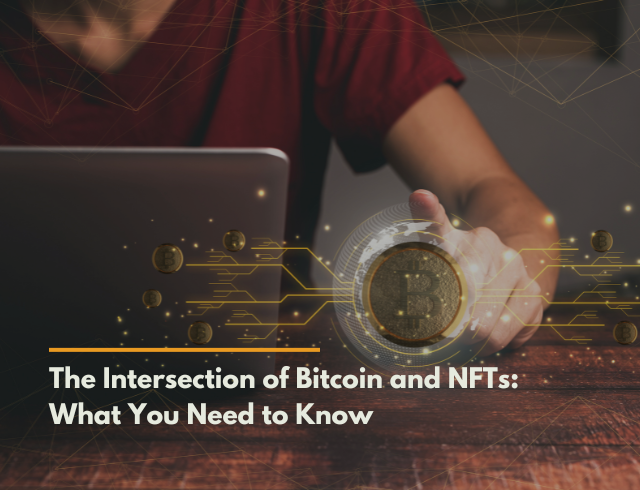

Then the world of cryptocurrency and digital art collided several years in the past, bringing with it broad-reaching alternatives – and challenges – for traders, artists, and technologists. The first and the most popular crypto coin of all is Bitcoin. As a result, it was followed by many blockchain innovations. A more interesting development includes NFTs. In this article, we are going to reveal how deep Bitcoin extends down into NFTs.
Understanding Bitcoin and NFTs
Bitcoin:
Bitcoin is a cryptocurrency and was invented by an unrecognized programmer. Or else, a group of programmers Satoshi Nakamoto in 2009. It can register transactions in a secure but transparent way with the help of cryptocurrency, well that’s blockchain technology. For quite some time, bitcoin has been described as a digital asset that people use most commonly to store value; in other words, “digital gold.
NFTs:
NFTs are tokens that serve as proof of ownership or authenticity. Also, for various items like art, music, videos, or virtual real estate. Unlike cryptocurrencies like Bitcoin or Ethereum which are interchangeable NFTs are one of a kind. Cannot be traded on a direct swap basis. Typically NFTs are created on blockchain platforms that enable contracts such, as Ethereum.
The Convergence of Bitcoin and NFTs
While Bitcoin and NFTs operate on different principles and blockchain technologies, their convergence is creating new avenues for innovation and investment. Here’s how:
1. Bitcoin-backed NFTs:
Conventionally, however, NFTs have been correlated with the Ethereum blockchain. Yet, there are new projects such as the RSK (Rootstock) protocol that bridges NFTs into the Bitcoin world. RSK is a platform that enables developers to create smart contracts. And NFTs using the security of the Bitcoin blockchain.
2. Cross-chain Interoperability:
Integrations like RSK and Stacks are trying to link the Bitcoin environment with other blockchains. For instance, Stacks allows smart contracts and NFTs. Also, they are resolved on the Bitcoin blockchain. This integration enables the users to enjoy Bitcoin. As a liquidity and security source and at the same time have access to the many prospects of NFT.
3. Enhanced Security:
This is considered to be very secure due to the consensus mechanism. Also, involves the use of miners and their support through the proof of work algorithm. Using Bitcoin’s blockchain for NFTs can work to the advantage of the creators and collectors of such assets as the instances of fraud are eliminated since the assets are real.
4. Investment Opportunities:
Bitcoin combined with NFTs is a new type of investment. NFTs could also attract Bitcoin holders who want to invest in NFTs without leaving the domain of the main cryptocurrency. On the other hand, it will be useful for NFT enthusiasts to start paying attention to the Bitcoin price and its constant fluctuation because it has become one of the driving factors for valuing digital assets and their amount by increasing the number of buyers.
5. Leading NFT Marketplaces:
Marketplace platforms are a very significant segment because they offer the necessary platforms for creators and buyers to interact through the selling/buying/trading of NFTs. Bermuda Unicorn which is amongst the premier destinations for NFT trading has been way out front concerning this movement. Being a hub for artists’ NFTs and ensuring secure transactions, Bermuda Unicorn stands for a diverse and healthy marketplace.
Potential Challenges
Despite the exciting opportunities, the convergence of Bitcoin and NFTs also presents challenges: Despite the exciting opportunities, the convergence of Bitcoin and NFTs also presents challenges:
1. Technical Complexity:
This integration presents some technical challenges that need to be solved about the interaction and expansion of NFTs within the Bitcoin environment. Since different blockchains are created by different developers, the latter has to ensure that there is a smooth transition between chains so that the process is as efficient as possible.
2. Market Volatility:
The market of Bitcoin and NFTs is quite volatile at the moment. To recover, investors have to be able to put into consideration the possibilities of risk such as price change and the occurrence of bubbles.
3. Regulatory Uncertainty:
Thus, the legal environment of cryptos and NFTs remains uncertain. Well, this is true because governments across the globe are trying to determine how to categorize and in turn, govern such cryptographic possessions. This implies that investors and creators should be abreast of trends in regulations to avoid contravening the law.
Conclusion
Bitcoin is yet another layer intertwined with NFTs, and this topic is rather promising and changing quickly, so there are countless possibilities and potential for investment. With more advancements in blockchain, there are chances of improving the connection between Bitcoin and NFTs, a perfect union. But for the participants, it is necessary to be aware of what kind of technical, market, and regulatory obstacles are present in this promising field to avoid failure. Assuming the role of an investor, artist, or blockchain fan, one will find it relevant to learn about the usage of Bitcoin and NFT in the future economy. Bermuda Unicorn and other marketplaces will remain essential for defining this area since they offer opportunities for content sharing for both creators and collectors in the sphere of NFTs.